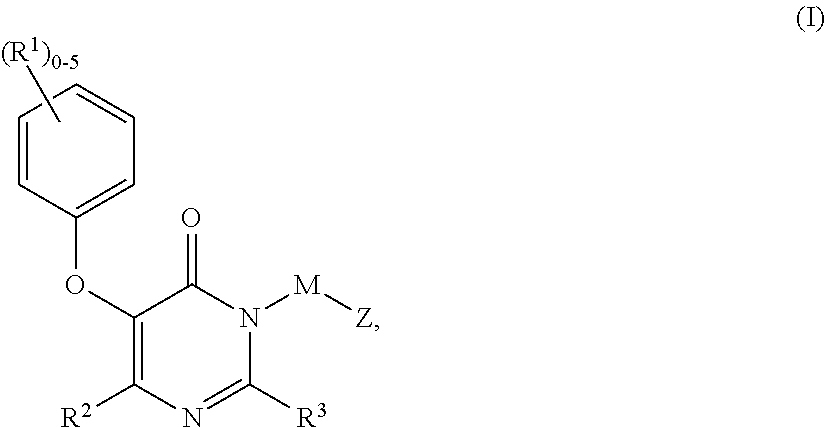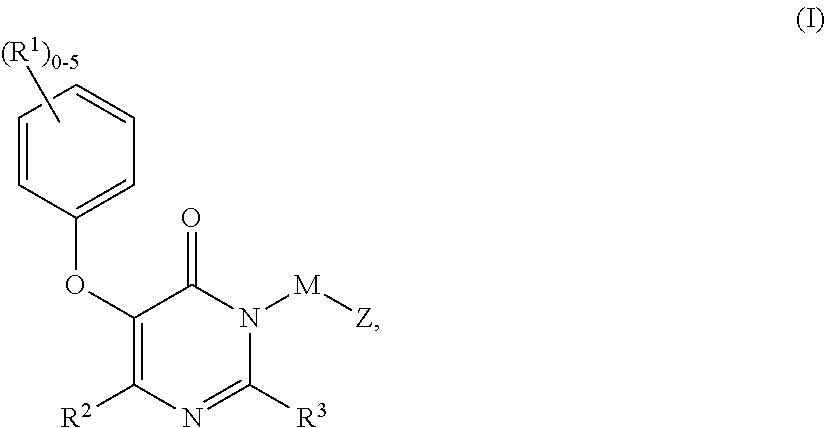Non-nucleoside reverse transcriptase inhibitors
a reverse transcriptase inhibitor and non-nucleoside technology, applied in the field of non-nucleoside reverse transcriptase inhibitors, can solve the problems of mutant hiv strains that are resistant to known inhibitors, and are highly susceptible to debilitating and ultimately fatal opportunistic infections
- Summary
- Abstract
- Description
- Claims
- Application Information
AI Technical Summary
Benefits of technology
Problems solved by technology
Method used
Image
Examples
example 1
3-chloro-5-((6-oxo-1-((5-oxo-5,6-dihydropyrido[2,3-d]pyridazin-8-yl)methyl)-4-(trifluoromethyl)-1,6-dihydropyrimidin-5-yl)oxy)benzonitrile
[0425]
Step 1: 8-(bromomethyl)pyrido[2,3-d]pyridazin-5(6H)-one
[0426]
[0427]To a solution of 8-methylpyrido[2,3-d]pyridazin-5(6H)-one (300 mg, 1.86 mmol) in CHCl3 (5 mL) was added NBS (363 mg, 2.05 mmol) and benzoyl peroxide (225 mg, 0.93 mmol) in turn. The mixture was stirred at 80° C. for 6 hr. After cooling to room temperature, the mixture was concentrated under reduced pressure and the residue was purified by preparative TLC (petroleum ether / ethyl acetate (1:1) as eluent) to afford 8-(bromomethyl)pyrido[2,3-d]pyridazin-5(6H)-one (210 mg).
[0428]MS (ESI) m / z 240, 242 (M+H)+
Step 2: 5-bromo-6-(trifluoromethyl)-4(3H)-pyrimidione
[0429]
[0430]To a solution of 8-(bromomethyl)pyrido[2,3-d]pyridazin-5(6H)-one (0.3 g, 1.8 mmol) in acetic acid (2 mL) was added CH3COOK (0.54 g, 5.5 mmol). Then to the mixture was added a solution of Br2 in acetic acid (1 mL) dr...
example 2
3-chloro-5-((1-((5-hydroxypyrazin-2-yl)methyl)-6-oxo-4-(trifluoromethyl)-1,6-dihydro pyrimidin-5-yl)oxy)benzonitrile
[0444]
Step 1: (5-chloropyrazin-2-yl)methyl methanesulfonate
[0445]
[0446]To a solution of (5-chloropyrazin-2-yl)methanol (750 mg, 5.2 mmol) and DIPEA (1.34 g, 10.4 mmol) in dichloromethane (10 mL) was added methanesulfonyl chloride (1.18 g, 10.4 mmol) dropwise at 0° C. The resulting mixture was stirred at r.t. for 0.5 hr. The mixture was diluted with ethyl acetate (30 mL) and washed with water, dried over sodium sulfate, filtered and concentrated under reduced pressure to give (5-chloropyrazin-2-yl)methyl methanesulfonate (800 mg).
[0447]MS (ESI): m / z 223, 225 (M+H)+
Step 2: 3-chloro-5-((1-((5-chloropyrazin-2-yl)methyl)-6-oxo-4-(trifluoromethyl)-1,6-dihydropyrimidin-5-yl)oxy)benzonitrile
[0448]
[0449]A mixture of (5-chloropyrazin-2-yl)methyl methanesulfonate (800 mg, 3.6 mmol), 3-chloro-5-((6-oxo-4-(trifluoromethyl)-1,6-dihydropyrimidin-5-yl)oxy)benzonitrile (907 mg, 2.88 mm...
example 3
3-chloro-5-((1-((4-methyl-5-oxo-4,5-dihydropyrazin-2-yl)methyl)-6-oxo-4-(trifluoromethyl)-1,6-dihydropyrimidin-5-yl)oxy)benzonitrile
[0455]
Step 1: 3-chloro-5-((1-((4-methyl-5-oxo-4,5-dihydropyrazin-2-yl)methyl)-6-oxo-4-(trifluoromethyl)-1,6-dihydropyrimidin-5-yl)oxy)benzonitrile
[0456]
[0457]To a suspension of 3-chloro-5-((1-((5-hydroxypyrazin-2-yl)methyl)-6-oxo-4-(trifluoromethyl)-1,6-dihydropyrimidin-5-yl)oxy)benzonitrile (30 mg, 0.07 mmol) and Cs2CO3 (68 mg, 0.21 mmol) in 1,4-dioxane was added CH3I (30 mg, 0.21 mmol). The mixture was stirred at r.t for 20 hr, filtered and concentrated under reduced pressure. The residue was purified by preparative HPLC to give the desired product 3-chloro-5-((1-((4-methyl-5-oxo-4,5-dihydro pyrazin-2-yl)methyl)-6-oxo-4-(trifluoromethyl)-1,6-dihydropyrimidin-5-yl)oxy)benzonitrile (10 mg).
[0458]1H NMR (CD3OD, 400 MHz): δ 8.63 (s, 1H), 8.01 (s, 1H), 7.71 (s, 1H), 7.54 (s, 1H), 7.35 (dd, J1=2.4 Hz, J2=4.4 Hz, 1H), 7.33 (d, J=2.4 Hz, 1H), 5.06 (s, 2H), 3....
PUM
 Login to View More
Login to View More Abstract
Description
Claims
Application Information
 Login to View More
Login to View More - R&D
- Intellectual Property
- Life Sciences
- Materials
- Tech Scout
- Unparalleled Data Quality
- Higher Quality Content
- 60% Fewer Hallucinations
Browse by: Latest US Patents, China's latest patents, Technical Efficacy Thesaurus, Application Domain, Technology Topic, Popular Technical Reports.
© 2025 PatSnap. All rights reserved.Legal|Privacy policy|Modern Slavery Act Transparency Statement|Sitemap|About US| Contact US: help@patsnap.com



